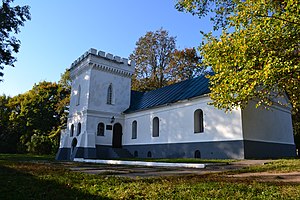| This article does not cite any sources. Please help improve this article by adding citations to reliable sources. Unsourced material may be challenged and removed. Find sources: "Lyzohubiv's Stone House" – news · newspapers · books · scholar · JSTOR (December 2016) (Learn how and when to remove this message) |
You can help expand this article with text translated from the corresponding article in Ukrainian. Click for important translation instructions.
|
| Lyzohubiv's Stone House | |
|---|---|
| Кам'яниця Лизогубів | |
 View from the northeast View from the northeast | |
| General information | |
| Address | вулиця Лизогуба, Sedniv, Chernihivs'ka oblast, 15522 |
| Coordinates | 51°38′29.94″N 31°34′3.9″E / 51.6416500°N 31.567750°E / 51.6416500; 31.567750 |
| Construction started | December 0, 1690; 335 years ago (1690-12-00) |
The Lyzohubiv's Stone House is a manor in Sedniv, Chernihiv Oblast, Ukraine. It is the oldest stone residential building on Left-Bank Ukraine. It was built for Yakiv Lyzohub of Chernihiv Regiment, member of the Lyzohub family.
Constructed in the 17th century, the building is a Ukrainian architectural monument.
History
The building was constructed in 1690 on the territory of the estate of the Chernihiv colonel Yakiv Lyzohub by his order by the same artisan team that was building the Church of the Nativity of the Virgin Mary in Sedniv at the same time. The roof was originally covered with shingles. In the second quarter of the nineteenth century, instead of a porch, a tower with Gothic windows, fortified by buttresses, was built on the main façade, crowned with a band of decorative mashikuls and merlon teeth. The house was painted in 1846 by Taras Shevchenko, who was visiting the then owner of the estate, Andriy Lyzohub. In September 1930, the monument was examined and measured in detail by the monumentologist Stefan Taranushenko. The house was partially destroyed in 1941-1943 during the Second World War. The restoration was completed in 1967.
After the restoration (1967), a beer bar was opened in the building, which angered the public. After a while, the bar was closed and the building was left without an owner, which led to its impoverishment: windows were smashed, the floor and doors were torn off.
In 2001, the building was restored by the Chernihivoblenergo Electricity Company to mark the tenth anniversary of Ukraine's independence.
References
This article about a Ukrainian building or structure is a stub. You can help Misplaced Pages by expanding it. |